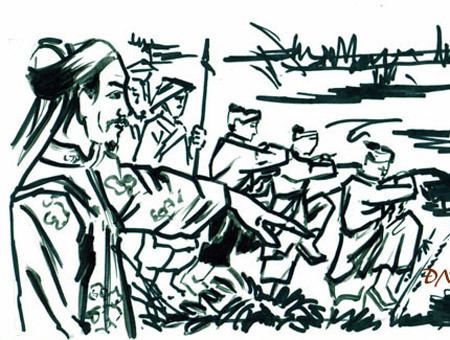Name Hau Nam | ||
 | ||
Hậu Lý Nam Đế (後李南帝, born Lý Phật Tử (李佛子), c. 518 – 606) was the last king of the Early Lý dynasty, founded by his cousin Lý Nam Đế. He reigned in Vạn Xuân (present-day north Vietnam) from 571 to 602.
Contents
Clash with Triệu Việt Vương

Lý was of Chinese descent. Lý Phật Tử and Triệu Việt Vương had a peace agreement in place; however, Lý Phật Tử had ambitions to claim to the entire territory of Việt people. Around 570 AD, Lý Phật Tử's army overran Long Biên, a region that belonged to Triệu Việt Vương, and seized it. Triệu Việt Vương was caught by surprise and defeated, he retreated to the river Đại Nha (now in Nam Định Province, northern Vietnam) where he killed himself. Lý Phật Tử then proclaimed himself Lý Nam Đế II and went on to rule Vạn Xuân (Vietnam) as an independent state for the next 32 years.
Fall of Lý Nam Đế II and the 3rd Chinese domination
In 602 AD, the new Sui dynasty emerged as the sole power in a unified China after having defeated the Liang dynasty. The new Sui Emperor Sui Wendi sent a 120,000-man army to invade Vạn Xuân and re-claim dominion over the Viet people. Lý Nam Đế II realized his army would not be strong enough to engage in a major conflict with the Sui invading force. At the same time, Lý Nam Đế II also received enormous pressure from his ruling administration to avoid any confrontation with the emerging Sui Dynasty. In the winter of 602, when the Sui force marched on Vạn Xuân, Lý Nam Đế II controversially decided to abdicate in exchange for peace and political stability in the region.
The Sui dynasty lasted only until 618 AD. It was replaced by the more powerful Tang dynasty. For the next 300 years, China continued to dominate Việt Nam until Ngô Quyền drove out a Southern Han army in 939 AD, and ushered in a long period of independence in Việt Nam history.
Aftermath of Early Lý dynasty
The Early Lý dynasty, although defeated, proved that it was capable of independence and self-rule. Through more than 60 years of rebellion and defiance, the national sentiment of Viet people was awakened. When the northern imperial power began showing signs of weakness and disunity at the end of the Tang dynasty, the Việt people would seize the opportunity to slip from under the Chinese rule.
